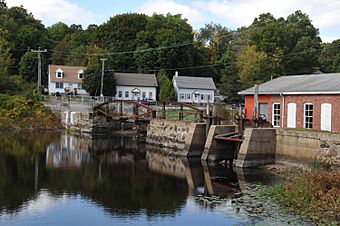Hallville Mill Historic District facts for kids
Quick facts for kids |
|
|
Hallville Mill Historic District
|
|
 |
|
| Location | Hallville Rd., Hall's Mill Rd., and CT 2A on Hallville Pond, Preston, Connecticut |
|---|---|
| Area | 50 acres (20 ha) |
| Architectural style | Late Victorian, Mid-19th-Century Revival |
| NRHP reference No. | 96000913 |
| Added to NRHP | August 22, 1996 |
The Hallville Mill Historic District is a special area in Preston, Connecticut. It was added to the National Register of Historic Places in 1996. This district shows what a textile mill village looked like in the 1800s.
It includes 23 old buildings, two other structures, and one site across about 50 acres. You can see the dam that creates Hallville Pond, old factory buildings, and homes where workers lived. There's also a unique bridge called the Hallville Mill Bridge, built around 1890.
Contents
What is Hallville Mill?
Hallville was once a busy village where people made cloth. The first mill here was built in 1752. It was a "fulling mill," which helped finish wool cloth made at home. Later, machines were added to prepare the wool for spinning.
A Village Built Around Cloth
In 1857, a weaver from England named Joseph Hall, Sr., built a large woolen mill. This mill was much bigger than the earlier ones. His sons later took over the business, calling it Hall Brothers' Woolen Mill. They kept making the mill bigger over many years.
By 1888, the mill employed 175 people. It produced a huge amount of cloth each year, about 860,000 yards (or 786,000 meters). This mill was very important for jobs and taxes in Preston. Even though the woolen mill burned down in 1943, other types of manufacturing continued in Hallville until the 1960s.
Why is This Place Special?
The Hallville Mill Historic District is important because it's a great example of a small 19th-century mill village. Many of its buildings and structures were part of a "company town." This means the mill company owned much of the town.
This area helps us understand how the local economy changed. It moved from farming to making things in factories during the late 1800s. It's like a living museum showing how people lived and worked during that time.
Protecting the Historic Village
Today, Connecticut Route 2A runs through Hallville. This road is a two-lane highway. More cars now use this road, especially because of nearby casinos like Foxwoods Resort Casino and Mohegan Sun. This increase in traffic is a concern. People worry it might affect the historic feel of the village.
Images for kids





